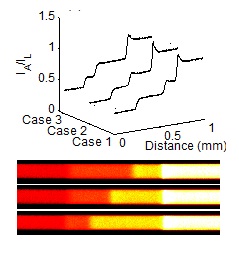Docket #: S07-333
Non-Focusing Tracers for Indirect Detection in Electrophoretic Displacement Techniques
Engineers in the Stanford Microfluidics Laboratory have developed a sensitive, high-resolution, label-free detection method for identifying and quantifying analytes on chip-based electrophoretic assays. This technology uses non-focusing fluorescent tracers (NFT's) which can be used with a variety of electrokinetic techniques, such as isotachophoresis (ITP), isoelectric focusing (IEF) and electrochromatography. As the tracers migrate through an ITP or IEF zone, the NFT's adapt to the local electric field in each zone. The zones can then be continuously visualized under a microscope to provide high resolution spatiotemporal data to resolve an analyte's chemical properties (e.g. pH, pKa, size, concentration and mobility). The technique can be employed in electrokinetic assays using virtually all common buffer systems, with a variety of applications for biological research, chemical and toxin detection, pharmaceutical compound preparation, and assay development.

Detection of two analyte zones under ITP with a counterionic fluorescent non-focusing tracer. The top pane shows the ratios of zone intensities and the bottom pane shows the corresponding images. The zones are, from left to right, TE (tricine), HEPES, MOPS, and LE (MES). The concentration of the tracer (50 µM R6G in the LE) increases in high mobility zones.
Applications
- Chemical and toxin detection - numerous chemical and biological agents and their hydrolysis products can be detected with non-focusing tracer detection (NFTD)
- Biological research - rapid detection of small biomolecules including RNA, DNA, peptides
- Pharmaceutical - can be used for precise extraction in preparative ITP or chiral separation
Advantages
- Label-free - indirect detection does not require any labeling step, simplifying the assay and reducing overall time and cost
- Sensitive - current sensitivity is ~100nM and the inventors are improving the tracers with a goal of 10nM
- Wide range of analytes detected - can identify compounds with virtually any mobility and most commonly-used pHs
- Portable system - the tracers can be used for detection using a hand-held, portable lab-on-a-chip system
- Versatile - NFTD technique can potentially be used in combination with other analytical assays, such as mass spectrometry, secondary ITP, reaction/digestion and chromatography
- Speeds assay development - an NFTD system gives assay developers instant and accurate measurements of buffer conditions throughout entire electrokinetic systems, and enables rapid visualization of complex and dynamic assays.
Publications
- "Non-focusing tracers for indirect detection in electrophoretic displacement techniques" (U.S. Patent Application, Published No. 20110220499)
- Chambers, R.D. and Santiago, J.G., “Imaging and Quantification of Isotachophoresis Zones Using Nonfocusing Fluorescent Tracers”, Anal. Chem, 16 March 2009.
- Khurana T.K. and Santiago J.G., “Effects of carbon dioxide on peak mode isotachophoresis: Simultaneous preconcentration and separation,” Lab on a Chip, vol. 9, 2009, pp. 1377-1384.
- Kaigala G.V., Bercovici M., Behnam M., Elliott D., Santiago J.G., and Backhouse C.J., “Miniaturized system for isotachophoresis assays”, Lab on a Chip, 2010. 10, 2242-2250.
Related Technologies
The Santiago Lab has developed a portfolio of technologies related to electrophoresis/isotachophoresis designed for lab-on-a-chip systems. This portfolio includes the following dockets:
“Microfluidic Sample Preconcentration Method Using Single-Interface Isotachophoresis” (Stanford Docket S05-338)
“Improved Control of Chemical Reactions using Isotachophoresis (Stanford Docket S07-084)
“Enhanced isotachophoresis with serial zones” (Stanford Docket S10-317 )
Related Links
Patents
- Published Application: 20110220499
- Issued: 8,721,858 (USA)
Similar Technologies
-
Sensor for Measuring Properties of Liquids and Gases S09-141Sensor for Measuring Properties of Liquids and Gases
-
Octave-wide mid-infrared frequency comb source S08-384Octave-wide mid-infrared frequency comb source
-
Wireless, Ultra-Low Power Implantable Device S13-173Wireless, Ultra-Low Power Implantable Device